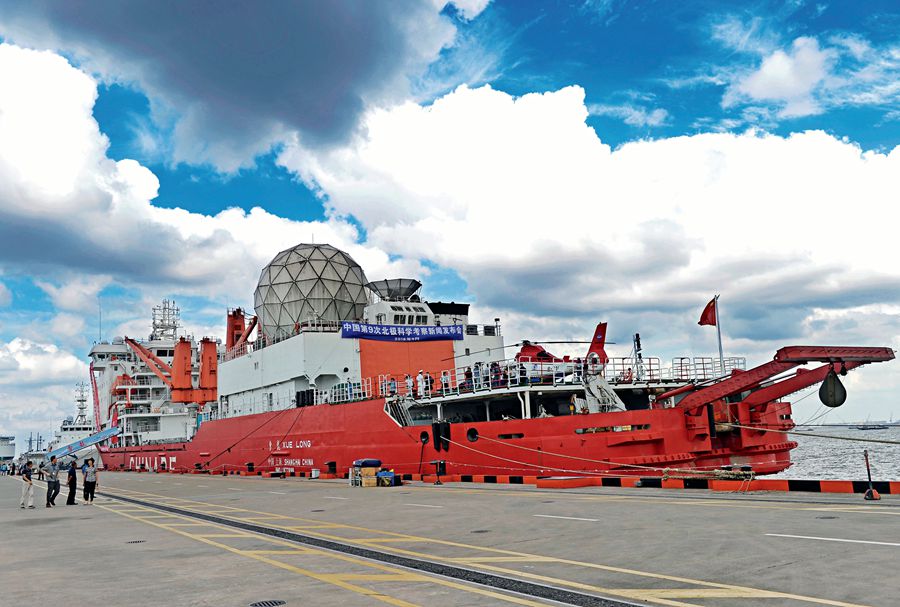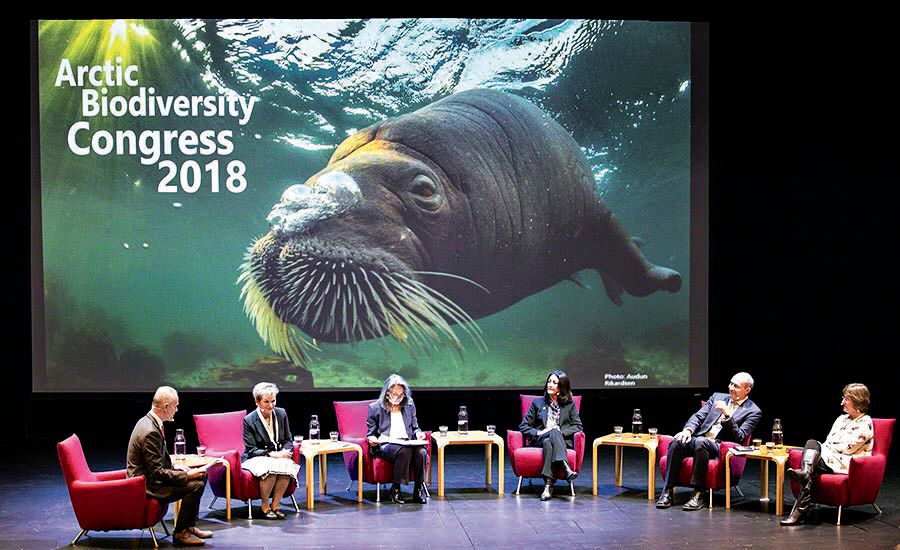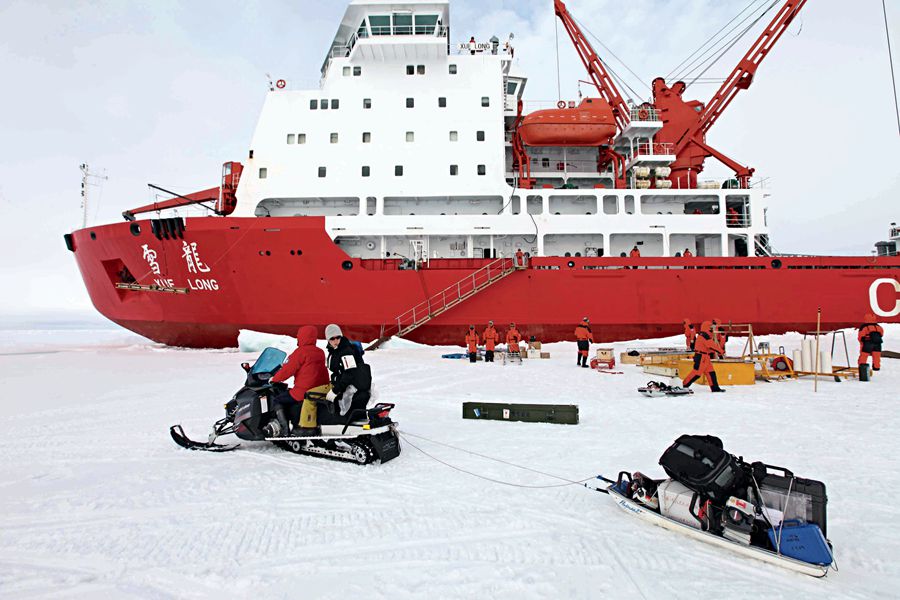CHINA surprised many in the international community when the State Council published a white paper in January 2018 titled China’s Arctic Policy. Canada, for example, with 40 percent of its land mass in its three northern territories and with 162,000 kilometers of Arctic coastline, has yet to release its long-anticipated northern plan; while China, more than 7,000 kilometers away from the Arctic Circle, has already mustered the political will to produce a comprehensive and positive Arctic strategy. The white paper on Arctic policy is one more indication of China’s intent to have a voice on all major issues of global governance.

On September 26, 2018, China’s Arctic scientific investigation team returns to Shanghai after its ninth expedition.
The Arctic is a vast sea surrounded by continents; while Antarctica is a continent surrounded by vast seas. The Arctic ocean occupies a roughly circular basin with the North Pole in the middle and covers an area of more than 12 million square kilometers or about the size of Antarctica. This ocean is surrounded by the five coastal states of Canada, Russia, the United States (Alaska), Norway, and Denmark (Greenland). The Arctic ocean, despite global warming, is completely covered by sea ice in the winter and partly covered by sea ice throughout the rest of the year. Four million people reside north of the Arctic Circle in the states bordering the Arctic ocean, unlike Antarctica which is uninhabited by humans except the scientists studying it.
So why is China interested in this distant and incredibly cold place? The first sentence of China’s white paper answers that question. The paper begins with the declaration that “global warming in recent years has accelerated the melting of ice and snow in the Arctic region.” This change in the environment poses a great security threat to China. Water levels on coasts have been rising due to melting ice and only a few inches added to the sea levels could cause devastating floods in coastal cities like Hong Kong and Shanghai. If the Greenland ice sheet melted completely, the levels of the ocean would rise about seven meters. Scientists at the non-profit institute Climate Central estimate that climate change of three degrees Celsius will affect 275 million people worldwide, with four of the five people affected living in Asia.
Because of the direct relationship between climate change, rising sea levels, and potential threats to millions of Chinese living in coastal cities through massive flooding, China has long participated in Arctic research. China joined the International Arctic Science Committee in 1996 and since 1999 has organized scientific expeditions in the Arctic with the research vessel Xue Long (or Snow Dragon) as the platform. In 2017, a second icebreaker – Xue Long 2 – was added to China’s fleet. In 2004, China built the Arctic Yellow River station in Ny-Alesund in the Svalbard archipelago. Given the threat of climate change, it is no surprise that the first goal enunciated in China’s Arctic policy is “to understand the Arctic” through capacity and capability in scientific research, and the second is “to protect the Arctic” by actively responding to climate change.

Participants take part in panel discussions during a plenary session at the Arctic Biodiversity Congress held in October 2018 in Rovaniemi, Finland.
The InterAction Council convened a meeting of Arctic experts in Rovaniemi, Finland, in October 2018 to discuss climate change and how to prevent its increase, and adapt to its impact. The Arctic locale was the right place to discuss global warming because the Arctic is warming at a rate twice that of the global average. The meeting coincided with the release of the United Nations Intergovernmental Panel on Climate Change report, which warned that there are only a dozen years for global warming to be kept to a maximum of 1.5 degrees Celsius, beyond which the risk of severe sea level rise, flooding, and extreme heat increases exponentially for hundreds of millions of people. With only a dozen years left to avert a disaster, the InterAction Council applauds China’s continuing commitment to the Paris Agreement to reduce the rate of global warming and deplores Donald Trump’s decision to withdraw the United States from the agreement.
There is also a paradox at play in these sobering projections on climate change: the melting ice will also allow shipping to use Arctic sea routes to connect Asia and Europe so economic development in the Arctic region will also be enhanced. In 2015, a cargo ship operated by the China Ocean Shipping Company sailed through the Northeast Asia passage, off the coast of Russia, from Dalian to Rotterdam to Tianjin. In August 2017, a Russian tanker sailed from Norway to South Korea without an ice breaker escort for the first time. Northern sea routes could cut 20 days from the 48 days it currently takes to get to Rotterdam from China via the Suez Canal.
The potential for Arctic sea routes is already achieved in air routes over the Arctic: because flights over the Arctic cut two hours from New York to Hong Kong, saving over 16,000 liters of fuel. There has been a 15-fold increase in polar air travel since 2003, with 14,000 flights taking place in 2016.
The economic importance of new shipping routes was recognized by the recent white paper and a significant policy announcement about “A Polar Silk Road” was the major news associated with the white paper’s release. The white paper recognizes that the Arctic shipping routes of the northeast passage off the Russian coast, the northwest passage off the Canadian coast, and the central passage over the North Pole “are likely to become important transport routes for international trade.” Therefore, “China hopes to work with all parties to build a Polar Silk Road” to develop Arctic infrastructure. The Belt and Road Initiative (BRI), of course, is one of the fundamental pillars of China’s foreign and economic development policies, potentially affecting 60 percent of the world’s population spread over 76 countries. The BRI is one of the most ambitious investment projects in recent history with an estimated cost 12 times greater than what the United States spent on the Marshall plan to rebuild Europe after the Second World War. A trillion dollar’s worth of projects are currently planned under the BRI framework. To include Arctic infrastructure within the scope of the Belt and Road is of immense significance to the four million people living in remote Arctic communities and demonstrates that China is interested in the Arctic for the long haul.

The China Arctic scientific investigation team transports equipment and supplies via a snowmobile at their station.
In September 2018, the InterAction Council met in Beijing for its 35th Annual Plenary on the theme of preservation and reform of world governance. President Xi Jinping urged the Council “to enhance consensus among all parties and promote the improvement of the global government system,” and in a meeting with InterAction Council leaders, Vice President Wang Qishan emphasized that “China will follow the path of peaceful development and promote the building of a community with a shared future for humanity.”
These principles are also clearly enunciated in the white paper on the Arctic. “China is committed to improving and complementing the Arctic government system,” the paper declares, and in doing so, the paper particularly mentions the Arctic Council. Created in 1996, the Arctic Council pulls together working groups of scientists and experts on key issues like climate change, a polar code for shipping, preservation of the permafrost, and sustainable development. The results of this shared expertise are then presented to the Council itself, which is composed of the representatives of the eight Arctic Nations, indigenous permanent participants, and accredited observers. In a victory for Chinese diplomacy, China became an accredited observer at the Council in 2013. The white paper declares that China “highly values the Council’s positive role in Arctic affairs and recognizes it as the main intergovernmental forum on issues regarding the environment and sustainable development of the Arctic.” The Arctic Council works through consensus among states, it assesses and applies the results of scientific expertise and gives an enhanced role to the indigenous peoples who live in that harsh climate. It is a model for the international system as a whole and the white paper highlights China’s commitment to playing a full and positive role within the Arctic Council framework.
The white paper concludes that “the future of the Arctic concerns the interests of the Arctic states, the well-being of non-Arctic states, and that of humanity as a whole.” The Arctic is the epicenter of the fight to preserve the planet from the effects of climate change. The region has the potential to make a major contribution to sustainable development, and through the Arctic Council it has a working model of cooperation on how the world should be governed. As a responsible large power, China’s commitment to the peaceful development of the Arctic is heartening and through the Polar Silk Road, China now has an instrument which will make it a stakeholder in Arctic affairs for generations to come.
THOMAS S. AXWORTHY is secretary general of the InterAction Council and a visiting professor at Zhejiang University.


